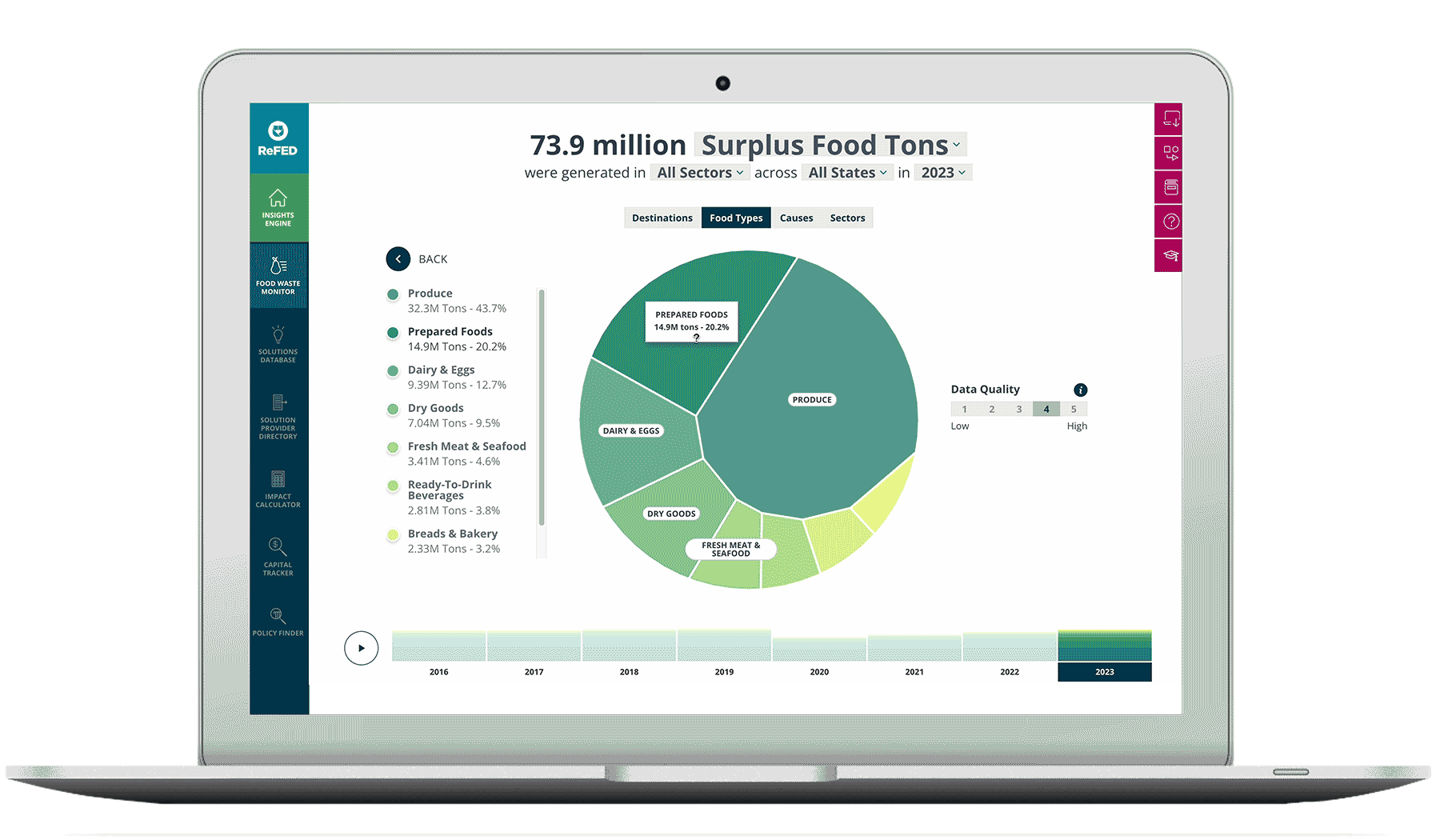Food Waste Impacts
Why Do Consumers Waste So Much Food—and What Can Be Done About It?
In most wealthy nations, including the United States, consumers are the largest source of food waste. While it is true that organizations and governments can help by reshaping consumer environments—especially when it comes to inconsistent date labels and unrealistic portion sizes—it is also true that a lot of the food being thrown away in homes comes down to habits and behaviors.
The bad news is that this comes with major consequences, both for the environment and for our wallets. And wasting food while 13.5% of people in the U.S. are struggling with food insecurity is also an unfortunate reality. The good news? The "Food Waste Five" make it easy, economical, and yes—delicious—to save food in your home. Check them out below.

Consumer Food Waste By The Numbers
In 2024, the average American spent $762 on food that went uneaten. Including uneaten groceries and restaurant plate waste, consumer food waste accounts for over 45% of surplus food in the U.S. at a cost of $259 billion. Plus, it has an annual greenhouse gas footprint of 144 million metric tons of CO2e (the same as driving more than 33 million passenger vehicles over the course of the year) and uses over 8 trillion gallons of water (the same as what could fill more than 13 million Olympic-sized swimming pools). It's also the equivalent of nearly 54 billion meals that could have gone to people in need.
Learn more about the impact of food waste on consumers and other sectors of the food system with the ReFED Insights Engine.

But even while we make changes to better manage the food we bring into our own homes, it’s important to note that businesses have a responsibility to support these efforts in a variety of ways. For example, when you’re eating at a restaurant, it can seem like you're getting a great value when big portions of food are brought to your table, but “plate waste”—all the food that you’re not able to eat, because there’s too much on the plate—is the biggest driver of food waste in restaurants. Or when you’re cooking a stew at home and need just a single rib of celery, but the grocery store requires you to purchase the whole stalk. You can probably think of lots of examples like this, where there’s an opportunity for a food business to help you to do the right thing when it comes to waste reduction.
GLP-1 Medications and Food Waste: What Are the Potential Impacts?
One in eight U.S. adults have reported taking a GLP-1, a class of medications that significantly impact eating habits and have broad implications for the food industry. From shifts in consumer eating habits and dietary preferences to a decrease in overall demand, we're especially interested in what GLP-1s could mean for food waste.
Read Article View Webinar"Food Waste Five"
So what can you do to reduce waste in your own kitchen? Start with these five easy-to-adopt strategies to get the most out of the food that you’re buying.
Plan Ahead
Don’t buy groceries without thinking ahead a few days or a week to consider what you’ll be eating.
Consider “recipe trios” to help use up food that you buy in bulk – for example, if you cook a roast chicken for dinner one night, make chicken tacos the next night, and chicken salad for lunch the following day.
If you’re going to eat take out or frozen pizza once or twice a week, plan for that too. That way, you'll know that you don’t buy anything else for that night and then end up not eating it.
Store Your Food Properly
Different foods need to be stored differently, and they’ll last a lot longer when they're stored right – for example, fresh herbs can be stored in a glass of water like flowers in your fridge; apples should be stored in the fridge, but oranges are fine on your counter; and bread should be wrapped in plastic or aluminum foil to retain its moisture.
Not sure how to store something? Just look it up online—there's a lot of great information that can help you.
Use Your Freezer
Your freezer is a magic “pause” button to keep food fresh longer.
Freezing food is a great way to extend its life—you can freeze most anything, cooked and uncooked (check online to see which is best for the foods you’re freezing).
An added benefit is that when you don’t feel like cooking, you can just take something out of the freezer to heat up and eat.
Learn the Labels
The most common date labels are “best if used by,” “sell by,” or “expires on” followed by a specific date—learning what labels really mean can save you from throwing something away when it’s still perfectly good to eat.
Date labels typically refer to quality, not safety. Major food industry groups have endorsed the use of “USE By” to indicate when a product should be discarded for food safety reasons and “BEST If Used By” to indicate that the date is simply about quality and the food can be consumed beyond that date.
So use your best judgment—if a product looks good, smells good, and tastes good, and has a “best by” or “best if used by” label, it’s probably OK to consume.
Eat Down
As you’re planning ahead for what you’ll be eating for the week, plan in a day to "eat down" all the leftovers and excess food collecting in your fridge.
Separately, they might not be enough for a full meal, but together, they’re just right.
Create a smorgasbord of leftovers for your family to graze on.
Make meals like tacos, soups, and salads, where you can be creative with a range of different ingredients.
Some people like Wasteless Wednesdays, others go with Stir-Fridays. Or always plan on bringing your leftovers to work for lunch and just pop them in the office microwave.
More Ways To Support Food Waste Reduction
As a consumer, you can use the power of your wallet to support businesses that are working to stop food waste. Here are some ways to do it:
Buy Upcycled Products
These are products that are made with ingredients that are byproducts of other products. Think delicious crackers made from veggie peels, seltzer drinks made with whey, and even pasta made from leftover grain. This is a growing and exciting group of products, so look for the official upcycled certified logo from our friends at the Upcycled Food Association.
Use Markdown Alert Applications
When food is at risk of going to waste, retailers and restaurants are using these apps to alert customers of discounted prices. Too Good To Go and Flashfood are two examples of these services—see which is available in your area.
Buy Ugly
A lot of food goes to waste simply because it doesn't meet the appearance standards of retailers. Companies like Misfits Market and Imperfect Foods offer a range of products that might be a little "ugly" but still taste great. Buy imperfect products at your regular grocery store too—you don't always have to reach for the reddest apple.
Meal Kits
Pre-portioned ingredients help you make sure you're only purchasing the amount you need. A range of services will deliver meal kits right to your house, and some grocery stores are offering their own in-house meal kit options as well. They're a great way to explore a range of menu options while also preventing waste.
What You Can Do
Follow us on social media
Follow our LinkedIn and Twitter pages and help share our news and resources—like this page!
Learn MoreStay Informed – sign up for our mailing list
ReFED’s mailing list is a great way to stay up-to-date on food waste, as well as track our work in the space. We also regularly share resources and announcements for a range of stakeholder audiences.
Sign UpVolunteer in your community
Food rescue organizations, as well as food banks and pantries, are always looking for people to help redistribute food at risk of going to waste to people struggling with food insecurity.
Learn MoreSupport our work
Our work helps reduce food waste across the food system, which is a key solution to the climate crisis. It also offers a range of co-benefits, including meal recovery, water savings, and job creation. We couldn't do it without your support.
Donate to ReFEDConsumer Resources

Roadmap to 2030
Food waste is a systemwide problem, and solving it will require a systemwide response. Our Roadmap to 2030: Reducing U.S. Food Waste by 50% looks at the entire food supply chain and identifies seven key action areas to help guide the food system’s efforts over the next ten years. In line with the "Target-Measure-Act" framework for food waste reduction that’s been adopted around the world, the Roadmap to 2030 is a critical blueprint to help the food system take action. View the entire report on this website or download our "at-a-glance" version with key highlights.
Solutions Database | Insights Engine
Impact Calculator | Insights Engine
ReFED Action Area: Reshape Consumer Environments
WRAP: Love Food Hate Waste
Save The Food -Food Waste Tips
Waste-Free Kitchen Handbook
USDA FoodKeeper App
EPA: Preventing Food Waste at Home
The key is helping consumers redefine value, so it isn’t only about the biggest or the cheapest, but a food system that prioritizes less waste.
